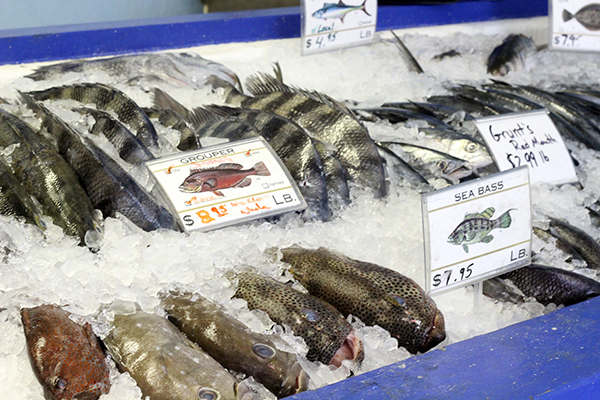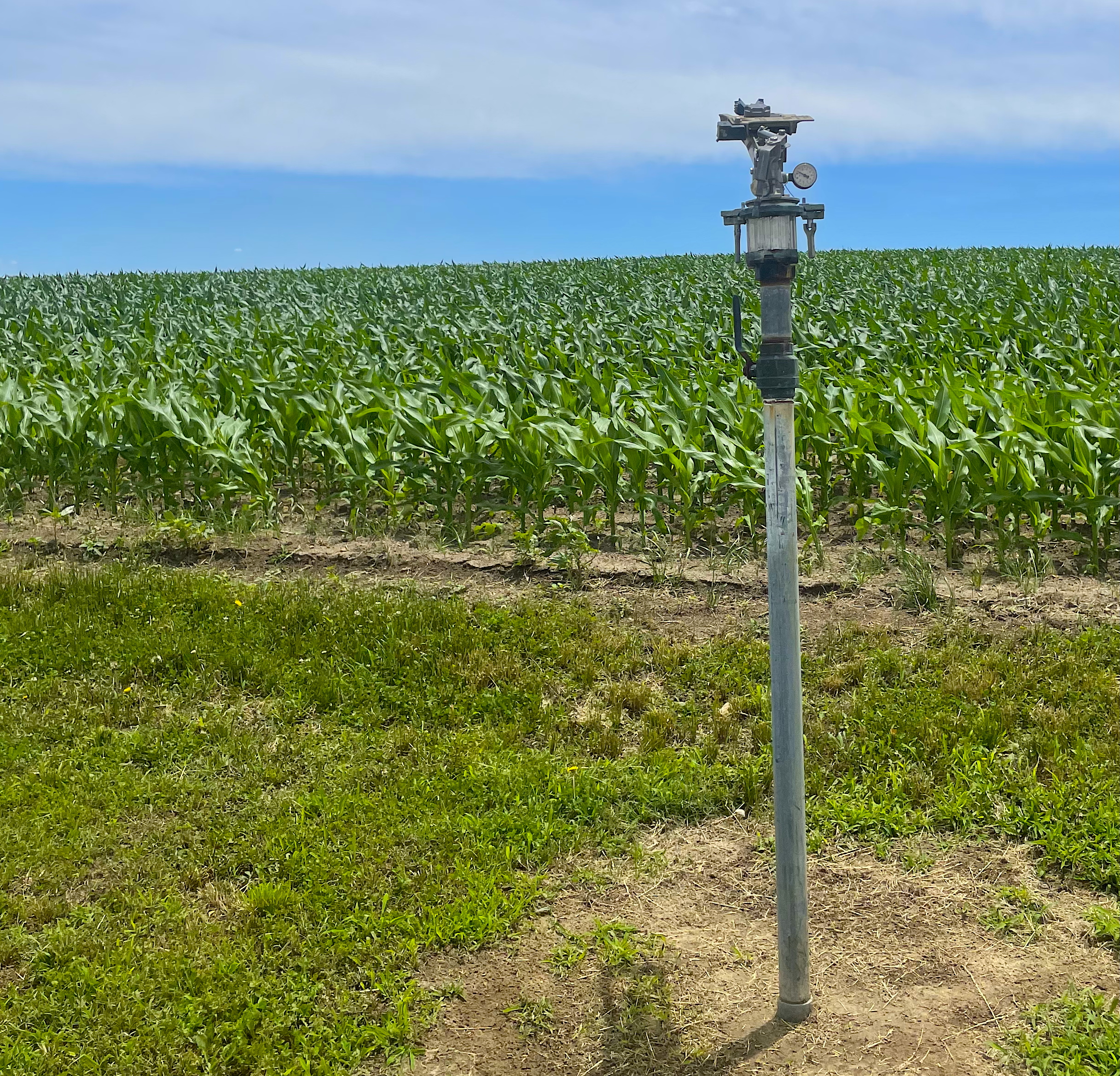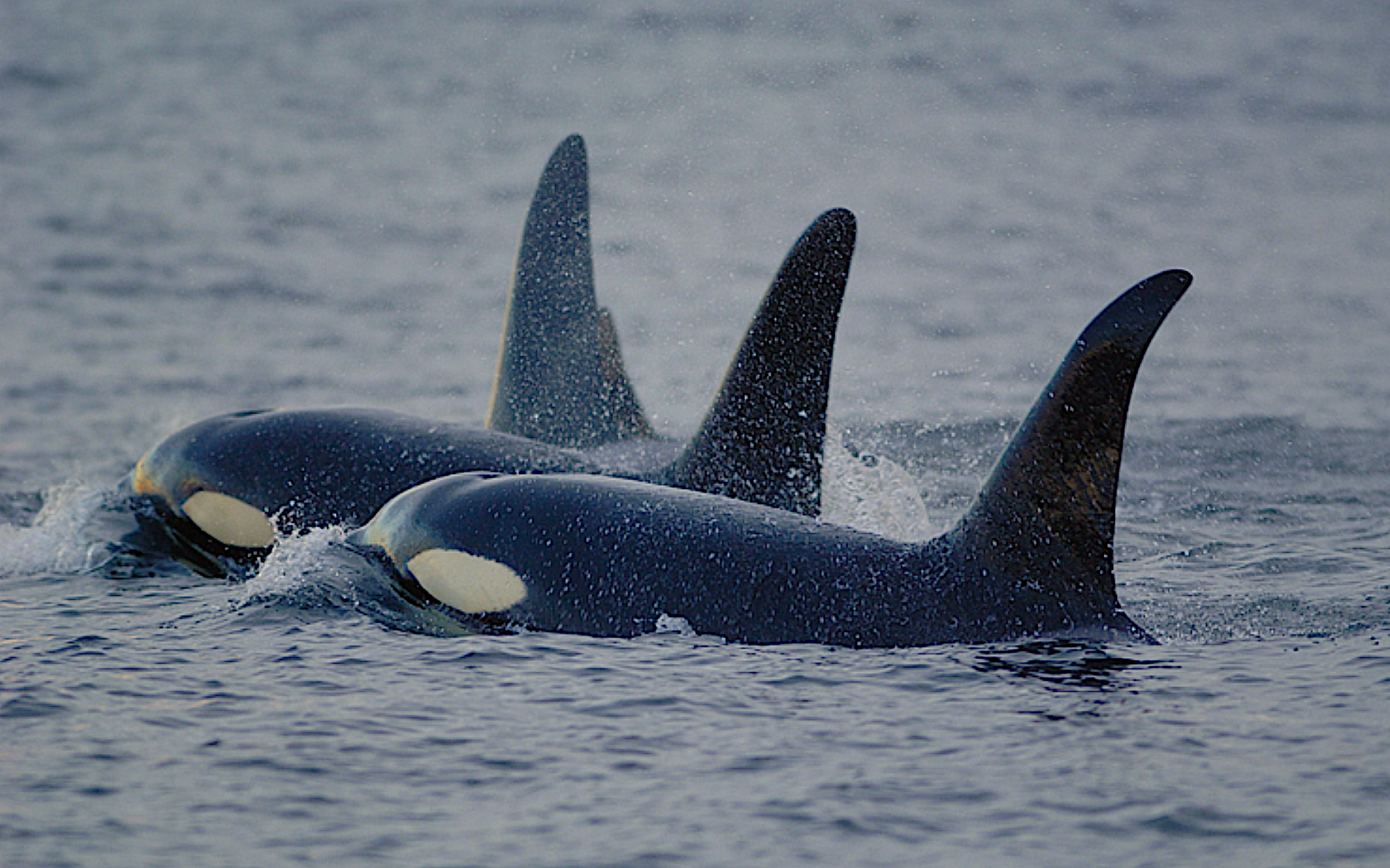North Carolina Seafood Shimmers Under Lights at Famed Fulton Fish Market

This article was published in the Spring 2004 issue of Coastwatch.
As Eric Voliva rolls a Wanchese Fish Company truck into the streets of lower Manhattan, the sky is pitch black except for the lights of the Brooklyn Bridge and skyscrapers.
Voliva stops the mauve 18-wheeler at the entrance of the famed Fulton Fish Market. A supervisor, bundled in a dark jacket, waves for him to go ahead.
“Pull in straight,” yells the man.
Immediately, Voliva maneuvers the truck behind another 18-wheeler. Then he rolls down the window and hands the supervisor 22 tickets for orders for North Carolina and Virginia seafood.
“This is real slow,” says David Woolard, who shares driving with Voliva. “A lot of times, you have 10 to 12 trucks in line. Usually the fork lifters are flying left and right. Most of the time, you can’t stand here because you might get run over.”
As soon as the truck in front moves, Voliva turns a corner and parks across from men huddled around wood crates burning in a metal barrel.
Although it seems slow to Woolard, there is still much activity at 1:45 a.m. Dealers with fish hooks on their shoulders bark orders. Men crack crates with hand axes. Drivers dart in and out with orange and black fork lifts like a demolition derby.
As soon as Voliva parks the truck, both he and Woolard hop out and unlock the back. Immediately, a young man jumps into the trailer and begins moving pallets of oysters and jimmy crabs toward the front.
A man in a wool cap lifts one pallet of jimmy crabs from North Carolina waters onto the forklift and then speeds away to a wholesale dealer.
Within 30 minutes, the truck is unloaded and on its way to JFK Airport, a Brooklyn seafood market and then Boston.
For Voliva, the hustle and bustle of the Fulton Fish Market is a familiar site.
“I have made this trip several hundred times,” he says. “Wanchese has four trucks. At least one or two trucks goes to the Fulton Fish Market Sunday through Thursday.”
As the largest fish market on the East Coast, the Fulton Fish Market is a key distributor for North Carolina seafood.
“I have been dealing with Wanchese Fish Company for 27 years,” says Patty Duke of Caleb Haley & Co. LLC. “I get 10 to 15 percent of croaker, bluefish and mackerel from North Carolina.”
Early Morning Market
The busiest time at the New York City market is from 2 a.m. until sunrise. “The real quality guys come early and buy before the market is established,” says Capt. Bill Mieschberger, a New York restaurant supplier.
Most restaurant chefs or seafood dealers arrive in trucks. A few pedal their bikes through the open markets. While looking at the fish, customers have to side-step puddles of melted ice and dodge workers unpacking seafood.
At the Fulton market, buyers can choose from seafood at more than 60 wholesale companies crowded into a four-square block. “I heard a billion dollars of fish are sold a year at this market,” says Vinny Tatick, owner of Joseph H. Carter Co. Inc.
Carter and the other wholesale businesses are housed in two open-front buildings owned by the City of New York and individual brick buildings along South Street. Outside, fish brokers work in the market where fish from around the world are displayed on ice — from pink porgy and grouper to octopus and skate.
At Caleb Haley, a whole tuna that weighs more than 600 pounds shimmers under the lights. “This tuna will go to a sushi purveyor,” says Duke.
After showing off the tuna, Duke holds up a swordfish for a customer. To see how much it weighs, he uses his hook to pick up the fish by the mouth and places it on a scale.
“Prices change every day and depend on the available supply of each species and the relationship between the dealer and the buyer and the buyer’s credit,” says Ken Gall, New York Sea Grant seafood specialist.
Each market has a speciality. At Samuels, they sell only saltwater fish. “Twenty percent of our fish is imported,” says Dave Sandberg. “Salmon is a big importer at this market.”
In 2005, the market — which has been in the same location for more than 160 years — will move to the Hunts Point Food Distribution Center in the Bronx.
The New York City Economic Development Corporation is constructing a state-of-the-art, 285,000-square-foot facility with controlled access. The new facility will be more efficient and cut unloading time by 50 percent, according to city officials.
Global Market for NC Seafood
Besides the Fulton market, North Carolina seafood goes to markets and restaurants all over the United States and overseas.
“We have such a large variety of seafood that it goes all over the world,” says William Small, seafood marketing specialist for the N.C. Department of Agriculture & Consumer Services.
“Some of the croaker goes to Africa and Korea” adds Small. “Hybrid striped bass is sold in Toronto. Farm-raised catfish are shipped to Europe, Japan and even Africa.”
The most lucrative North Carolina seafood is blue crab. In 2002, the blue crab catch was valued at more than $36 million, according to the N.C. Division of Marine Fisheries (DMF). North Carolina has consistently been a leading producer of blue crabs. In 1998 and 1999, North Carolina was the number one producer of blue crabs in the United States, harvesting more than 55 million pounds each of these years, according to Small.
Despite the high value of blue crab, the industry has been struggling since the 1990s. In less than five years, more than half of the states processors have been forced to shut down, according to DMF.
The downturn in the blue crab industry can be attributed to a number of factors. Catches of crabs have dwindled over the last five years, and the crab season was shortened. At the same time, an influx of less expensive, imported crabmeat has been nudging out the domestic market share.
In addition, lingering effects from a series of hurricanes in 1996 and 1997 altered estuarine habitats, and the crab supply further declined.
“We had an accelerated shift from domestic to imported products, says North Carolina Sea Grant researcher Dave Green, who heads N.C. State’s Center for Marine Sciences and Technology in Morehead City. “We no longer can be commodity-based because we can’t compete at the commodity level.”
Green and Barry Nash, North Carolina Sea Grant seafood technology and marketing specialist, have been working with North Carolina seafood processors to develop value-added products, which are processed to be different in form, taste and texture from the principal raw ingredients.
One of the successful products is Wanchese Fish Company’s scallop medallion that is sold at the Fulton market. Developed through a N.C. Fishery Resource Grant program that is administered by Sea Grant, the medallion uses enzymatic cold-binding to create large scallops from smaller, less profitable ones.
N.C. Marketing Campaign
To compete in a global market, the N.C. General Assembly began appropriating funds for seafood marketing in 1998. In the 2002-2003 fiscal year, $200,000 was budgeted for seafood marketing.
For blue crab and other seafood, Small’s office began a “Freshness from North Carolina Waters” (FFNCW) program. The FFNCW label may be applied only on North Carolina produced, processed or packed seafood products, according to the membership criteria.
“Our program is generic and focuses on all North Carolina seafood,” says Small. “It will help fishermen and processors market their products by letting consumers know the products they are buying arae top quality and locally harvested.”
The campaign’s goal is to create a positive image in the public’s mind about all North Carolina seafood and aquaculture products through our “Freshness From North Carolina Waters” program, he adds.
Because of increased competition from Vietnam, China and Thailand in the shrimp industry, the 2003 Congress authorized $17.5 million of disaster relief to the South Atlantic states. In North Carolina, Smith’s program received $600,000 to develop a 36-month shrimp marketing campaign to promote the virtues of fresh, local shrimp.
There really is a difference between foreign and North Carolina shrimp, says Small. “Our domestic, wild-caught shrimp are safe to eat, untainted, clean and have a firmer flesh that tastes better than the almost bland flavor of the imported product. We also are trying to increase awareness of the abundance and nutritional value of shrimp in North Carolina.”
Truck Ride to New York
Five days a week, Wanchese Fish Company’s mauve trucks deliver seafood caught by their boats and other North Carolina companies across the East Coast.
On Sundays through Thursdays, the 18-wheelers leave from Wanchese Fish Company’s office in a concrete building on the waterfront in the tiny community of Wanchese. The trucks go to Boston, Baltimore, Philadelphia and New York markets.
On a recent day, one man loaded some crabmeat and hard crabs onto to one truck and fish on to another with a forklift. The seafood is stored in a refrigerated section of the trailer.
“We freight everybody else’s seafood,” says Cruiser Midgett of Wanchese Fish Company. “We send at least five trucks a week to New York. Sometimes we send as many as 10 to 15. We are not packing as many fish as we used to because of more government regulations.”
After the trucks are loaded, the drivers arrive. First, Voliva, a burly man dressed in a T-shirt and jeans loads his quilt, cooler, and pillow into the back of the cab — an efficiency apartment with curtains separating the driving section from bunks, tiny closets, a cubby hole wired for a T.V. and refrigerator. The front has a CB radio and a state-of-the art map tracking system.
A few minutes later, Woolard, a tall man with glasses, puts his belongings in the back. Woolard is one of eight Wanchese Fish drivers who transport seafood back and forth on the East Coast. Two pairs are husband and wife teams.
On the drive to New York, Voliva leaves the parking lot at the seafood company around 2 p.m. First, he heads down N.C. 345 past businesses and a long stretch of marsh. Then he turns and crosses the causeway to Nags Heads and N.C. 158 west.
Voliva says hauling seafood is a “steady job, and you get 31 cents a mile when go up and extra for anything you take back.”
For Voliva, who has been driving a truck since 1984, the route is familiar — from a cluster of shopping centers in Kitty Hawk to the bumpy ride the over the Wright Memorial Bridge on Currituck Sound.
“I like driving a truck because you get to see different things up and down the road,” he says. “I couldn’t stand being couped up in office.”
As Voliva heads through the Great Dismal Swamp, the road narrows, and blackbirds flutter over the green water that looks like a bowl of green soup.
“When I see a swarm of blackbirds, it reminds me of what my grandfather always told me — that cold weather was coming,” says Voliva. “My grandfather had a home on the Scuppernong River and took me out fishing.”
Pickup Point
The first stop is Quality Crab Company in Elizabeth City where the drivers pick up some oysters. Then they head down the highway to Virgina. After going over a one-lane bridge in Suffolk County, Va., Voliva turns into Wanchese Fish Company’s new state-of-the-art, 180,000-square-foot facility, which has a large loading dock.
At the plant, the drivers, along with Wanchese Fish Co. president Joey Daniels, load more seafood on the truck.
After the Virginia stop, the drivers don’t pick up or deliver any seafood until they get to New York.
“We don’t make any stops unless necessary,” says Voliva. “We try to get to the New York market as early as we can. The busiest nights are Sunday and Wednesday because trucks come up from Florida. On Sundays, sometimes we leave at 7 a.m. out of Wanchese to be the first or second in line.”
At the Virginia plant, Woolard takes over the wheel. Voliva gets in the back, closes the curtains and takes a snooze on the bunk. “We split up driving every three to five hours,” says Woolard.
As the sky begins to turn ink black, the drive becomes an endless stretch of dark open fields through Virginia and Maryland. Calls on the CB radio and bathroom and fast food stops interrupt the monotony.
“Sometimes, you know the people on the radio,” says Woolard after getting a call. “You try to help one another.”
In Delaware, the refineries in Wilmington light up the night sky. Then Woolard stops in a service area for diesel fuel, and Voliva takes over the wheel.
Voliva says one of the drawbacks of the job is that it is “hard on his family.”
“Sometimes, you are on the road all week and don’t go home at all,” he says.
Truck drivers also have to deal with road rage from other drivers.
“You have to keep an eye on everything and everybody,” says Voliva. “I give people plenty of room. Just say ‘yes ma’am and no ma’am’ to yourself. Let them cool off and go about their business.”
Along the Jersey Turnpike, the traffic picks up. As Voliva maneuvers onto the Queens Expressway, he says that a lot of drivers won’t drive into New York City.
“The scariest time is going into New York in the ice and snow,” says Volvia.
The ride gets bumpy when Voliva hits the Geothals, Bayonne and Verrazano bridges. Then the Manhattan skyline, including the Empire State Building and the Chrysler Building, illuminates the sky. He turns into a narrow street near the market.
After making the trip hundreds of times, Voliva can deal with just about anything.
“Sometimes, people push you around at the market,” he says. “You have to not let them intimidate you. They use hard language but don’t mean no harm.”
For contact information and reprint requests, visit ncseagrant.ncsu.edu/coastwatch/contact/.
- Categories:


